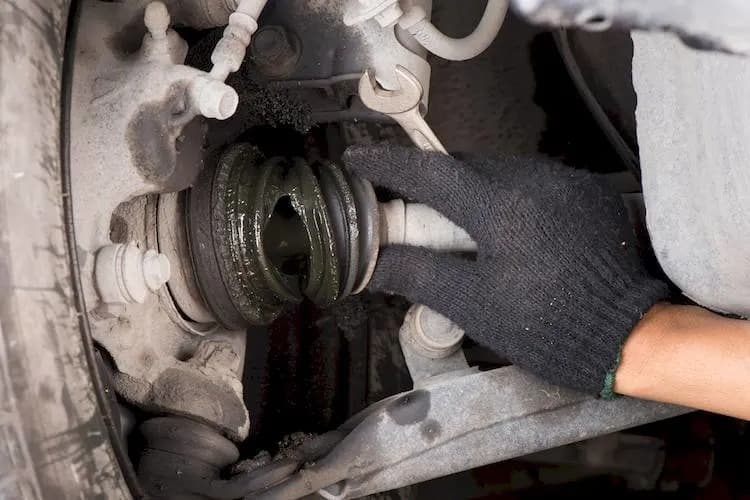Leaks in your car’s axle seals can cause a number of problems, from decreased fuel efficiency to dangerous driving conditions. If you suspect your seals are leaking, it’s important to troubleshoot the problem as soon as possible. In this blog post, we’ll discuss the causes and symptoms of axle seal leaks, as well as some tips for troubleshooting and repairing them.
Table of Contents
- Leaking axle seals and why they are a problem
- Causes of leaking axle seals, including wear and tear, improper installation, and damage
- Symptoms of a leaking axle seal
- How to fix leaking axle seals
- Conclusion
- FAQs about leaking axle seals
Home » Leaking Axle Seals: Causes, Symptoms and Troubleshooting Tips
Leaking axle seals and why they are a problem
Leaking axle seals can be a major problem for any car owner. They are responsible for connecting the wheels to the axle, but if they become worn or damaged they can allow motor oil and other transmission liquids to leak out.
This not only affects performance, but it is also unsightly and can have potentially serious long-term consequences. Not only can this cause undue expense due to costly repairs, it can also endanger your safety by reducing the control over your vehicle while on the road. As such, axle seal leaks should be addressed as soon as possible in order to keep your car in peak working condition.
Causes of leaking axle seals, including wear and tear, improper installation, and damage
Leaking axle seals are a pesky car problem that can be caused by several different factors. Wear and tear is typically the main cause of axle seepage from seals, as regular use and time takes a toll on their integrity. Improper installation of the seal can also be to blame for the leakage, due to incorrect measurements or positioning when fitting the part in place.
Additionally, impacts and abrasive contaminants can inflict damage on the seal—oftentimes resulting in an inability to effectively keep fluids and debris out of your vehicle’s transmission components. Thus, it is important to stay vigilant regarding these causes when troubleshooting this issue so you can secure an informed solution.
Symptoms of a leaking axle seal

A leaking axle seal is often unmistakable due to the potential combination of telltale signs. When looking for leaks, first inspect for any fluid dripping from the axle, followed by grease or dirt. Additionally, a loud whirring noise or low humming sound may accompany the problem, indicating that something is wrong. Paying attention to these symptoms can help you prevent further damage to your vehicle and save you time and money in costly repairs down the road.
How to fix leaking axle seals
Addressing a leaking axle seal can be quite daunting; However, with the right tools and knowledge, it is a feat that can be accomplished. First, the vehicle must be raised up so that the axle seals are level to inspection. After the seals have been located and inspected for any visible signs of damage or wear, one should then move on to replacing them.
This requires draining the oil from within and removing any components that may interfere with the process. Once all these steps have been completed, two new axle seals must be affixed in place with approved installation techniques such as using a hammer and socket to drive them down. Ensure you fill drained fluids back into the oil tank before starting up your vehicle after this repair is completed.
Conclusion
In conclusion, axle seals are an important part of your car’s function, and keeping them well-maintained is critical to avoiding expensive repairs down the road. Be sure to check for symptoms of a leaking seal regularly and take your car in for service at the first sign of trouble. With proper care, you can keep your axle seals functioning properly for years to come.
FAQs about leaking axle seals
What are the most common causes of leaking axle seals?
The most common causes of leaking axle seals are wear and tear, improper installation, and damage. Wear and tear of the seal can occur over time due to regular use, causing the seal to weaken and eventually fail. Improper installation of the seal can also cause seepage, if not installed correctly or measured accurately during fitting.
What are the symptoms of a leaking axle seal?
The symptoms of a leaking axle seal can be quite noticeable and should not be ignored. One of the most common signs is fluid or grease leaking from the axle, indicating that a seal has been breached. In addition, a loud whirring noise or low humming sound may accompany this leak.
How do I fix a leaking axle seal?
Fixing a leaking axle seal can be a challenging process, but with the right tools and knowledge, it is not impossible. First, the vehicle must be raised up so that the axle seals are level to inspection. Once they have been located, inspect them for any signs of damage or wear such as fluid or grease leaking from the axle.
What is the best way to prevent axle seal leaks?
Fixing a leaking axle seal requires a bit of know-how, but with the right tools and techniques, it is certainly achievable. First, the vehicle must be raised up off the ground so that the seals can be inspected at a level angle. It is important to note that this repair should not be undertaken without proper safety precautions in place.
How often should I check my axle seals for leaks?
It is important to regularly check your axle seals for any signs of damage or wear, such as fluid or grease leaking from the axle. This should be done on a regular basis, at least once a month, in order to ensure any potential issues are caught and addressed quickly.


